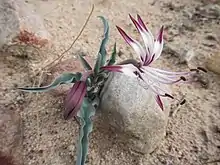Ornithoglossum undulatum
Ornithoglossum undulatum, also known as the Karoo Slangkop, is a species of flowering plant in the family Colchicaceae. It is found in Southern Namibia and South Africa.[1] In South Africa its range extends as far east as Somerset East in Eastern Cape Province.[2] O. undulatum is a poisonous plant, and consumption of the leaves can kill livestock.[3]
| Ornithoglossum undulatum | |
|---|---|
 | |
| Scientific classification | |
| Kingdom: | Plantae |
| Clade: | Tracheophytes |
| Clade: | Angiosperms |
| Clade: | Monocots |
| Order: | Liliales |
| Family: | Colchicaceae |
| Genus: | Ornithoglossum |
| Species: | O. undulatum |
| Binomial name | |
| Ornithoglossum undulatum Sweet, 1825 | |
It is also known as the poison onion, cockatoo snakelily, or wave-leaved bird's tongue.[4][1] The Afrikaans moniker of slangkop means "snake's head," referring to the resemblance of their flowers to a snake's head.[3]
While not rated under the IUCN Red List, the South African National Biodiversity Institute (SANBI) Red List rates this species as "least concern" as of 2005.[5]
Description
The plant can grow from 5 to 20 centimeters in height. There are two to four leaves that are lanceolate in shape which are undulated, the leaves are 10 centimeters in length and are a blue-grey color.[4] The flowers are zygomorphic and nodding downwards on pedicels, they range in color from white to pink, with maroon tips, and are fragrant during the night.[4][2] The plant flowers between the months of April and July.[2] They are most often found on rocky terrain, usually in granite or sandstone slopes.[4] The plants are perennials and have an underground corm.[3]
Distribution
Ornithoglossum undulatum is found within the provinces of Eastern Cape, Northern Cape, Western Cape in South Africa.[5] In Namibia it is found throughout the ǁKaras Region, concentrated in the Richtersveld and Namaqualand regions.[4][3]
Cultivation
Ornithoglossum undulatum grows well in well drained soil with moderate or little watering required. The plant favors heavy sunlight, owing to its desert habitat.[1]
References
- "CAUDICIFORM Ornithoglossum undulatum". www.bihrmann.com. Bihrmann's Caudiciforms. Retrieved 17 October 2021.
- "Ornithoglossum | Pacific Bulb Society". www.pacificbulbsociety.org. Pacific Bulb Society. Retrieved 17 October 2021.
- Latti, Ivan. "Ornithoglossum undulatum". Operation Wildflower. Retrieved 17 October 2021.
- "Ornithoglossum undulatum". www.llifle.com. Encyclopedia of Living Forms. Retrieved 17 October 2021.
- "Threatened Species Programme | SANBI Red List of South African Plants". redlist.sanbi.org. South African National Biodiversity Institute. Retrieved 17 October 2021.